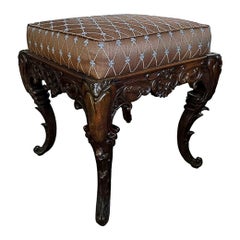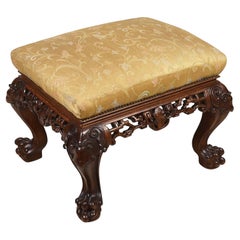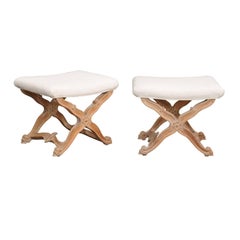Mahogany Stools
2
to
1
1
2
2
2
41
20
19
18
16
9
9
7
6
4
2
2
1
1
1
Height
to
Width
to
Depth
to
2
21,993
14
8
7
4
2
2
1
1
Style: Rococo
Material: Mahogany
Gillows Country House Stool
Located in Sturminster Marshall, Dorset
A finely carved mahogany Gillows design library stool/ coffee table. Turned and stylised acanthus leaf decorated legs with a solid brass top block to leg...
Category
16th Century British Rococo Antique Mahogany Stools
Materials
Brass
Early 19th Century Rocco Style Hand Carved Mahogany Stool
Located in Banner Elk, NC
Early 19th century Rocco style hand carved mahogany stool with re-upholstered top.
Category
Early 19th Century English Rococo Antique Mahogany Stools
Materials
Mahogany
Related Items
Art Deco Stool, Material Iron, Country France, 1930
Located in Ciudad Autónoma Buenos Aires, C
Stools Art Deco.
Material: iron
You want to live in the golden years, this is the stool that your project needs.
We have specialized in the sale of Art Deco and Art Nouveau styles since 1982.If you have any questions we are at your disposal.
Pushing the button that reads 'View All From Seller'. And you can see more objects to the style for sale.
Why are there so many antiques in Argentina?
In the 1880 – 1940 there was a grate wave of immigration encouraged by the periods of war that were taking place.
1st World War took place between 1914 and 1918
2nd World War took place between 1939 and 1945
The immigrants options were New York or Buenos Aires. Tickets were cheap and in Buenos Aires they were welcomed with open arms, as it was a country where everything was still to be done.
Argentina was the country of new opportunities, labour was needed and religious freedom was assured, in many cases the of the family travel first until they were settled and then the rest of the family members join them.
In the immigrant museum “Ellis Island Immigrant Building” in New York you can se the promotional posters of the boats that would take them to a new life.
Between the years 1895 and 1896, Argentina had the highest DGP (gross domestic product) per capita in the world according to the Maddison Historical Statistics index, this situation arose due to the large amount of food being exported to European countries, which were at war.
The Argentinean ships left the port of Buenos Aires with food, but they returned with furniture, clothes and construction elements, (it´s common to see this the old buildings of the historic neighbourhood of San Telmo, the beams with the inscription “Made in England)”, as well as many markets that were built in Buenos Aires, such us the San Telmo Market, whose structure was brought by ship and afterwards assembled in 900 Defensa Street.
With the great influence of European immigrants living in the country, the children of the upper classes travelled to study in France, resulting in the inauguration of “La Maison Argentinienne”, on 27th of June 1928, in the international city of Paris, which hosted many Argentinians that were studying in Frace.
It´s the fourth house to be built after France, Canada and Belgium, being the first Spanish-speaking one. Still in place today (17 Bd Jourdan, 75014, Paris, France). Many of the children of these wealthy families who attended international art exhibitions, museums and art courses abroad, took a keen interest in the European style. This is why Buenos Aires was at the time referred as “The Paris of South America”.
Between the years 1890 and 1920 more than a hundred Palaces were built on Alvear Avenue the most exclusive avenue in Buenos Aires. Today some of these palaces have been transformed into museums, hotels and embassies.
In the year 1936, the Kavanagh building was inaugurated, it was the tallest reinforced concrete building in South America.
During 1994 the American Society of Civil Engineers distinguished it as an “international engineering milestone”, and it´s now considered a World Heritage of Modern Architecture.
At the time was common to hire foreign architects such as Le Corbusier, who visited Buenos Aires/Argentina in 1929 and in 1948 he drew up the blueprints for a house built in La Plata City (which was declared a World Heritage Site).
In 1947, the Hungarian architect Marcelo Breuer designed “Parador Ariston” in the seaside city of Mar del Plata. After an Argentinean student at Harvard University convinced him to come to Argentina. He worked on an urban development project in the Casa Amarilla, area of La Boca.
The Ukrainian architect, Vladimiro Acosta, arrives in Argentina in 1928 and worked as an architect until que moved to Brazil.
Antonio Bonet, a Spanish architect who worked with Le Corbusier in Paris, arrives in Argentina in 1937, where he carried out several architectural works and in 1938 designs the well-known BFK chair.
Andres Kálnay, of Hungarian origin, made around 120 architectural masterpieces, among which the former Munich brewery stands out, he even made the furniture’s design.
The German architect, Walter Gropius, director of the Bauhaus, lived in Argentina, where he wrote articles for “Sur” magazine and founded in Buenos Aires, an architectural firm with Franz Möller, who was also an architect, where he built two houses.
At the same time several famous designers decided to immigrate to Argentina, among them we can find the well-known French designer, Jean-Michel Frank, who arrived in the country in 1940 and also worked for the Rockefeller family.
Special pieces were made, which were sold exclusively in the country, such as the well-known German company “WMF”, who sold their products by catalogue, which were chosen by the ladies of high society in the list of wedding gifts, as well as the pieces designed by Christofle.
The Swiss sculptor Alberto Giacometti, made special pieces for Argentinean mansions.
In 1904 the first Jansen branch outside Paris was established in Buenos Aires, as the Argentinean clientele demanded a large amount of furniture, from the end of the 19th century to the mid-20th century.
In 1970, the brand Rigolleau Argentina made pieces authorised by Lalique.
The brands Maple and Thompson also set up shop in the country.
The French plastic artist, Marcel Duchamp moved to Argentina in 1918-1919.
Glass signed Gallé, Charder, Leverre, Schneider, Muller and other French firms. They were bought in flower shops and were given to ladies with beautiful floral arrangements.
Some furniture manufacturers travelled to international fairs and bough the patterns to produce the furniture in Argentina, such as the furniture firm Englander and Bonta, who bought the patterns ins Italy.
It is worth mentioning that in Argentina we have the largest community of Italians outside...
Category
1930s French Art Deco Vintage Mahogany Stools
Materials
Iron
19th Century Oriental Carved Wood Stool
Located in Brighton, Sussex
A wonderfully stylish 19th century Oriental style stool, with pierced fretwork decoration to the frieze, stuff over upholstered seat, raised on classical carved cabriole legs with my...
Category
19th Century French Antique Mahogany Stools
Materials
Mahogany
WIV Style Gillows Designed Leather Upholstered Stool
Located in London, GB
This gorgeous and very functional WIV styled Gillows designed leather stool features deep buttoned cocoa brown upholstery supported on 6 turned reeded le...
Category
2010s British William IV Mahogany Stools
Materials
Leather, Mahogany
Vintage Country French Rush Seat Stool / Bench
Located in West Palm Beach, FL
Vintage country French pine stool with rush seat. Carved legs and stretchers with a light wash.
Category
20th Century French Country Mahogany Stools
Materials
Rush, Pine
Antique Genuine Northern Swedish Country House Pine Stool
Located in Kramfors, SE
Antique Swedish country stool made in northern Sweden around the mid 1800s. The stool is made by hand from solid pine. It has a round, unusually thick seat with three legs. In charmi...
Category
Mid-19th Century Swedish Country Antique Mahogany Stools
Materials
Pine
Antique Country French Tripod Stool with Rush Seat
Located in West Palm Beach, FL
Charming antique country French tripod rush seat stool with hand carved slats and legs.
Category
19th Century French Country Antique Mahogany Stools
Materials
Rush, Walnut
19th Century Walnut Child's Stool, Hand Carved
Located in Los Angeles, CA
19th century original walnut child's foot stool that is hand carved. It has a wonderful aged patina.
Category
19th Century American Adirondack Antique Mahogany Stools
Materials
Walnut
19th Century French Louis XV Style Hand Carved Gilt Wood Foot Stool Tapestry
Located in Sofia, BG
Beautifully executed with fine attention to details, French Louis XV style carved gilt wood stool on cabriole legs ending with snail feet, deco...
Category
Mid-19th Century Louis XV Antique Mahogany Stools
Materials
Tapestry, Giltwood
H 7.09 in W 25.6 in D 9.06 in
Pair of Hollywood Regency X-Frame Stools Gillows of Lancaster style
Located in Pemberton, NJ
Lovely pair of Hollywood Regency X-base stools in the style of Gillows of Lancaster.
Category
Mid-20th Century American Hollywood Regency Mahogany Stools
Materials
Brass
19th Century Mahogany Stool
Located in Bedfordshire, GB
A very good quality mid-19th century mahogany stool, of diminutive proportions, having attractive needlework drop in seat to frame with elegant carved decoration, raised on cabriole ...
Category
Mid-19th Century English Victorian Antique Mahogany Stools
Materials
Mahogany
19th Century Mahogany Stool
Located in London, GB
With stylised ‘X frame’ legs and faded green velvet top.
Category
Mid-19th Century British Antique Mahogany Stools
Materials
Mahogany
Early 19th Century Oak Joint Stool
Located in High Point, NC
Early 19th century oak joint stool from England with a beveled edge around the top, following down to a simple apron with molded banding...
Category
Early 19th Century English Georgian Antique Mahogany Stools
Materials
Oak
Previously Available Items
Elegant Large Early 19th Century Mahogany Country House Stool
Located in Benington, Herts
An elegant early 19th century mahogany on a beechwood framed stool of country house proportions upholstered in a damask.
English circa 1830
This wonderfully drawn stool...
Category
1830s English Rococo Antique Mahogany Stools
Materials
Upholstery, Mahogany
Vintage Italian Pair of X-Frame Rococo Style Bleached Wood Stools
Located in Atlanta, GA
A pair of Italian X-frame Rococo style bleached wood stools from the mid-20th century with upholstered seats. Each of this pair of Italian mahogany stools, circa 1930-1950 features a rectangular seat covered with new muslin upholstery, over a beautifully carved x-frame base. Made of a delicate scrolls breaking the rigidity of the typical X-shape, the legs are adorned in their junction with carved rosettes. The scrolled feet are connected two by two with side stretchers, showcasing a discreet asymmetry, typical of the Rococo taste. The simplicity of the bleached wood contrasts nicely with the elegance of the curvy lines, making this pair of Italian carved stools...
Category
Mid-20th Century Italian Rococo Mahogany Stools
Materials
Upholstery, Mahogany
Recently Viewed
View AllMore Ways To Browse
Set Brass And Black Counter Stools
Navy Blue Stool
Plastic Counter Stool
Red Leather Bar Stools
Green Foot Stool
Hills Manufacturing Lucite
Knoll Bar Stools
Copper Bar Stools
Round Danish Stool
Knoll Bar Stool
Industrial Metal Navy Chair
Square Foot Stool
Salon Stools
Round Low Stool
Lodge Dining Chairs
Metal Base Counter Stools
Zieta Stool Blue
Bed End Stool





